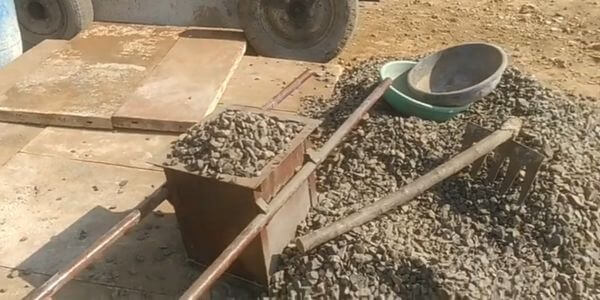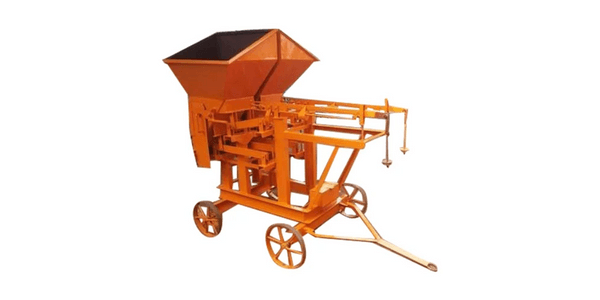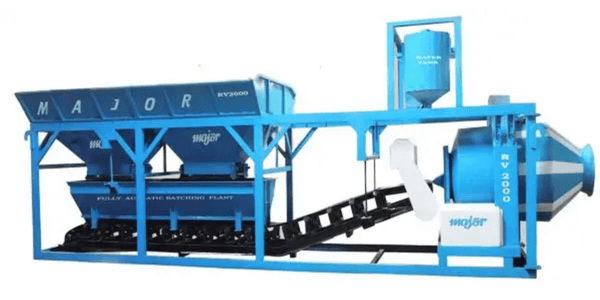Table of Contents
What is Batching of Concrete?
Concrete batching is the process of measuring the components needed to make concrete, such as cement, sand, aggregate, and water, to ensure adequate mixing in accordance with the mix ratio.
To make high-quality concrete, a precise amount of each ingredient should be used. Concrete batching is a method of calculating the amount of ingredients required for concrete production.
Accuracy for measuring cement, aggregates, and water should be within 3% of the batch quantity, and for admixtures, 5% of the batch quantity.
The two most popular techniques for batching concrete are weigh batching and volume batching.
The batching method used is entirely determined by the required standards and the size of the job. However, it is frequently employed and strongly advised to adopt the weigh-batching approach.
Batching of concrete is important for achieving workability, strength, durability, and economy.
Methods For Batching of Concrete
The two methods of batching of concrete are as follows:
- Volume Batching
- Weigh Batching
Volume Batching of Concrete
Volumetric batching is commonly utilized for concrete production in small construction projects. In this batching process, each ingredient for concrete is measured by its loose volume.
A gauge box, a piece of specialized equipment, is used to measure them. The gauge or measuring boxes have been made significantly more in-depth with a narrow top surface to make estimating the top level easier.

Cement is consistently measured by weight, regardless of the batching method. The volume of a 50 kg bag of cement is 0.035 m3. A gauge box has a volume of 0.035 m3.
Since the density of water is measured in kilogram per liter (kg/L) and water is measured in liters, the effect of fine aggregate bulking should be updated if volume batching is used.
Weigh Batching of Concrete
All major projects employ the weigh-batching method for cement concrete. Weigh-batchers come in many different shapes and sizes. For smaller projects, manual batching is used.
The ingredients are completely weighed and mixed by hand. Weighing can also be done with standard platform weighing machines.

For major projects, weigh bucket equipment is used. Hoppers feed the weigh buckets, which in turn feed the mixer by gravity with the materials.
There are automatic batching plants available that can be operated electrically or manually and have capabilities varying from small to large. However, they function in the same way.
By pressing a button, all the various materials are started to weigh, and when the desired weight is reached, each material’s flow is stopped. similar to a water bottle being filled from a spout.
Some of the most advanced batchers graphically record the weight of the individual item that is supplied to each batch. Weigh batching does not utilize graduated buckets to add water because the water could spill.
The tank on the mixer can be vertical or horizontal. Any quantity of water can be accommodated by the filling due to its design.

Difference Between Volume Batching and Weigh Batching
- Since it is challenging to determine the precise volume of granular materials due to their voids, weigh batching is a more accurate form of batching than volume batching.
- The aggregate’s moisture content and its presence should be considered before batching. It is possible in the event of completely automated weigh batching, however, volume batching is not appropriate in such circumstances.
- The compressive strength of the identical concrete mix at 7 and 28 days is higher for weigh batching than for volume batching.
- Weigh-batching concrete results in a medium to very high slump, whereas volume batching produces a slump that ranges from low to high for the same mix proportion.
- While weighing batching calls for expert labor, volume batching does not.
- The size of the project and the rate of concrete production define the batching technique that is used.
Factors Affecting the Selection of Batching Method
The selection of a batching system is affected by the following factors:
- Task size: Depending on how much work needs to be done with the approach, a batching method for concrete will be chosen.
- Concrete production rate: This depends on the quantity of concrete that must be produced each day or per house.
- The precision of weight measurement on the basis of performance standards for batches
- Batch weighers might be mechanical or electronic.
- Although mechanical weight batches are less common today than electronic weight batches, some factories still utilize them as a fallback for electronic weight batches.
- The weight of concrete components is measured using a spring on dial-type scales in mechanical weight batches. Electronic scales are suspended from electronic weight batches by load cells, which translate force into a quantifiable electrical quantity. Hopper, tank, or other containers that translate the stress into an electrical signal sustain the load cell. Electronic scales measure precisely and frequently don’t need to be repaired.
- A variety of electronic batch weighers are available. Weight batches should be employed in high-silo, low-profile, or underground batch plants, depending on the type of plant. The batches could be non-stationary ones that weigh transport commodities or stationary ones that weigh people who aren’t moving while they weigh.
FAQs
What is batching process of concrete?
“Batching” refers to the procedure of measuring ingredients or resources to produce concrete mix. Volume batching and weight batching are two techniques for batching. To produce a high-quality concrete mix, batching must be done correctly.
How many methods of batching are there?
Weighing and volume batching are two different methods of batching. The volumetric measure of the ingredients is obtained during volumetric batching.
What is the purpose of batching concrete?
The Concrete Batching and Mixing Plant’s main goal is to provide homogeneous, uniform concrete, as demonstrated by physical characteristics such as unit weight, slump, air content, and strength in both single batches and subsequent batches of the same mix proportions.
Which type of batching is most suitable?
The two most popular approaches to concrete batching are volume batching and weigh batching. The needed criteria and the size of the project are the only factors that affect which batching technique is used. The weigh batching approach is popular, though, and it is strongly advised.
Also, Read
What are the properties of Fresh Concrete?
Water Cement Ratio – Definition, Importance, And Calculation
Plum Concrete – Purpose, Ratio, Specification, And Uses
What is Concrete Spalling – Cause, Effects & Repair